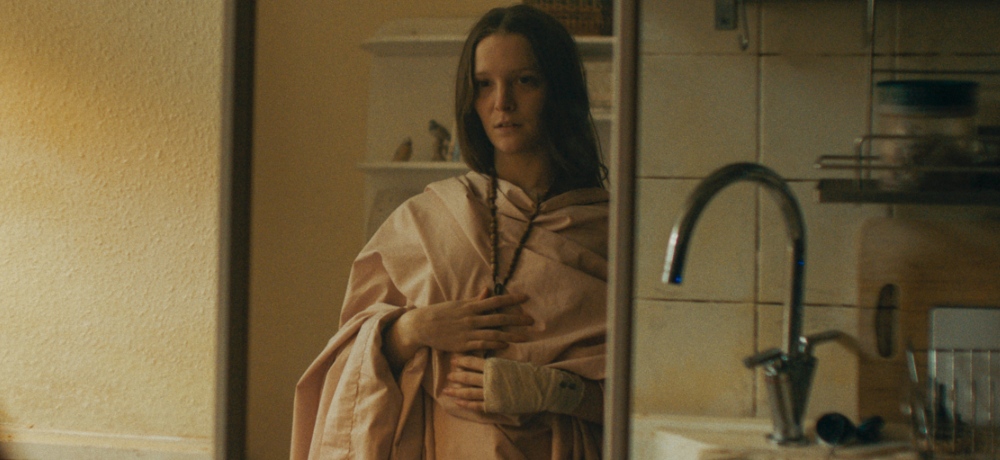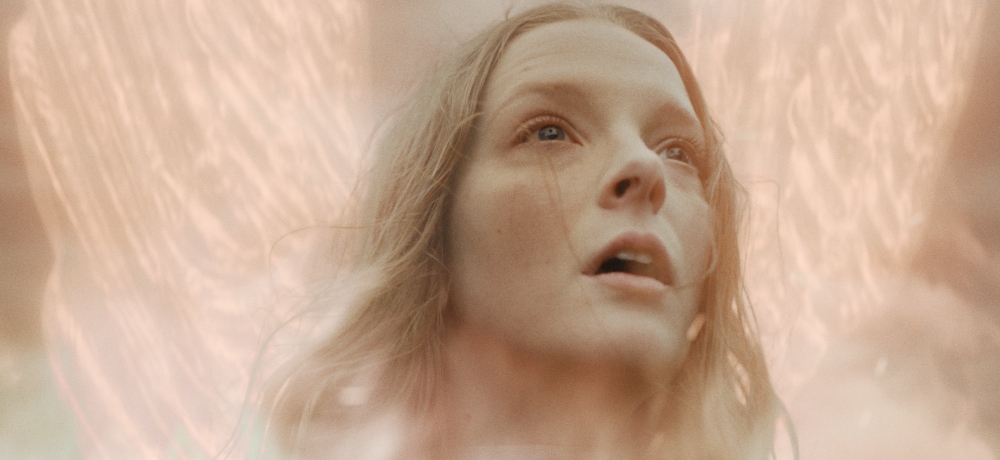


[Spoiler warning for those who haven’t seen Saint Maud.]
In our current culture, the divine is held at a safe, unsullied distance from the physical. In the US, we can thank the nation’s roots in Puritanism and the popularity of Protestants for a notion of the spirit that places holiness in some unreachable, airy realm and keeps sin anchored in the physical body (and within the temptation of physical sensation and pleasure). However, when looking back on history and through the scope of Catholicism’s historical evolution, that boundary between the body and the divine becomes blurry.
Understanding the divine used to be linked intimately with understanding the mysteries of the body, through early medicine and the earliest attempts to grasp and define God by early theologians. The history of the divine is just as much a history of the saints that wore their faith on their skin and in physical sensation. It’s this bodied divine that is connected to the central horror of Saint Maud.
In the debut film of writer and director Rose Glass, Saint Maud allows audiences to witness the horrific test of a young woman’s devotion. Maud is a hospice nurse with a troubled and sinful past who has renewed her devotion in extreme and all-consuming ways. She becomes obsessed with saving the soul of her dying patient as sinister forces pull at them both. The film stars Morfydd Clark and Jennifer Ehle (best known from the 1995 Pride and Prejudice miniseries).
Saint Maud is laden with symbols of this tense relationship with the bodied divine. The most obvious example is Jennifer Ehle’s character, Amanda, a former dancer known for her sensual and strange choreography. After a life of worldly decadence and bodily indulgence, she is sick and dying and now resigned to the decay of her body in the emptiness of her beautiful home. Amanda’s home is full of rich texture and patterns, and posters of the dancer’s body (with some sneaky 666 symbolism thrown in there)—a temple to earthy delight. Amanda is the personification of the corruption of the body as both a smear against holiness and a fitting punishment for sinfulness.
Maud works as a natural foil to Amanda, as the Madonna to the Whore or the divine to the earthy. Maud has renewed her faith and dedicated herself fully to the purifying of her soul and to the salvation of others. Her life is in stark contrast to Amanda’s, she chooses to live in self-inflicted poverty modeled after the devotions of St. Francis of Assisi and his disciple St. Clare. Piety through stripping away material comforts is a common exercise of Catholic devotion, practiced throughout history, but Maud’s devotion goes one step farther as she engages in extreme mortifications of the body. Her stark, saintly lifestyle is accompanied by the torments of walking in shoes with nails embedded in the soles and kneeling on uncomfortable stones in the fashion of other saints.

Beyond the Franciscan influences depicted in the character, Maud is very clearly inspired by St. Mary Magdalene. Much of Maud’s appearance and mannerism in the film is inspired by classic artwork depicting the female saint. Images and icons of St. Mary Magdalene are scattered throughout Maud’s rooms and home. As Maud studies holy texts, she is most often seen referencing images of this particular saint, and, for good reason, as St. Mary Magdalene is an obvious patron for Maud.
This saint particularly speaks to Maud’s character as St. Mary Magdalene is the patron saint of recent converts, penitent sinners, and people that are ridiculed for their piety. On the surface, St. Mary Magdalene’s presence in Saint Maud points to the struggles of a young woman who is relentlessly mocked for her fervent devotion, but the symbolism of Mary Magdalene goes much deeper, making a much more interesting argument for the film.
In addition to the aforementioned patronage, St. Mary Magdalene is a saint directly connected to sexual temptation and women. Though her past is murky, viewers get a vague sense of Maud’s sinful nature prior to her newfound piety. That sexual energy is crucial to Maud’s devotion and faith.
I know I’ve drawn a lot of comparisons between St. Mary Magdalene and Maud, but the picture of this unique character would not be complete if we didn’t throw St. Catherine of Siena into the mix. St. Catherine of Siena is one of the most famous medieval mystics due to her immense influence, uncommon for women in the Church, during her life and persisting after her death. St. Catherine of Siena was an educator and injected her ideas and writings into the politics of her time. She was hell-bent on salvation, and her body and severed head have become one of Italy’s most iconic medieval holy relics. Maud’s motivations and characterization exists between these notable female saints, with one massive devotional concept binding them together: spiritual marriage.
One of Saint Catherine’s most notable mystical phenomena was her claim to be spiritually wed to Christ. She claimed that she wore a ring of His foreskin (yes, really) and her devotion to this spiritual marriage led to future body mortification and physical penance being described by Catherine as vital to her physical union with her holy spouse. While St. Mary Magdalene’s spiritual marriage was not as explicitly documented, the mysterious history of Magdalene is rooted in her uncommon intimacy with Christ.

Interpretations of St. Mary Magdalene have ranged from medieval sermons that allege Mary is a reformed prostitute, to early Gnostic texts that claim she was a wife and confidant to Christ and the envy of all other disciples. Even outside of the Catholic Church, historic study of early theological writings shows this struggle with the bodied divine and with physical intimacy becoming intertwined with spiritual intimacy. Female religious figures exist as heavenly spouses, male religious authorities grapple with the belief that souls become married to God (resulting in some strangely homoerotic interpretations). Which brings us solidly to Maud’s bodied divinity in Saint Maud.
Maud comes to her newly found faith, seeking forgiveness for a past transgression of an unclear but likely violent nature. As she describes the presence of God to Amanda, she describes a warm and spreading sensation through her body. She references God as being inside her. To the contemporary audience, it’s easy to connect the dots between Maud’s ecstasy in her faith and sexual ecstasy. It’s a conclusion that only makes more sense when exploring early theology and the holy marriage of the soul to God and the surrender of the body to that devotion.
A common conclusion that has been drawn about Saint Maud is that the central question in the film is whether or not Maud is actually in a close relationship with God, or if she has gone insane and only imagines that presence. I would argue, by virtue of the bodied divinity of the saints and the approach of the film, that there’s no doubt Maud is connected to God in the film. The questions that do arise are:
Is Maud’s relationship with God loving or abusive? Is her bodied divinity born out of love or punishment? Therefore, can we trust that it’s God acting on Maud, or a sinister force?
Maud’s bodily experience with God exists beyond her own arousal in connection with her faith and the old-school asceticism she practices. The supernatural elements of the horror film come into play as we see something at work in Maud’s body. In an early scene, Maud gasps as she feels God’s presence. She touches her neck softly, indicating pleasure, and slowly rears her head back in a wide-eyed strangled expression that cuts so quickly that it is hard to tell if what she’s experiencing is pleasure or pain. This happens more than once in Saint Maud, with the line between pleasure and harm being blurred until eventually at the film’s climax the viewer sees Maud limp and in utter surrender float up into the air.
In the second act of the film, when Maud has lost her job and is now being “punished” for her devotion, she feels distant from God. She feels that she is not being rewarded for her piety. She does not feel that divine push or presence. What does she do? She self-soothes with two casual sexual encounters. She fills that void left by God’s supposed abandonment in an extremely specific way. This snaps the early encounters mentioned previously into a tighter focus.

The horror of Saint Maud is rooted in skepticism in whether or not God is a figure that we can fully entrust our surrender and devotion to. At the risk of oversimplifying, Saint Maud postulates that God is a bad boyfriend and that Maud is the casualty for her inability to break free. The final scene of the film makes a compelling case here and puts the final nail in this exploration of the bodied divine.
Believing that she is now ready to ascend, Maud dons herself in a fashion that again hearkens to St. Mary Magdalene. She ventures down to the beach and douses herself in gasoline before lighting a match. What the viewer sees first is Maud as a vision of perfection. Her hair is dry, her face clean, and her body not bearing the marks of her torment. She has an ethereal glow about her and looks out on the crowd of onlookers that has fallen to their knees. Every image from this scene is pulled out of countless historic accounts of saints who experience a final miracle in death. It is usually the presence of such a posthumous miracle that eventually makes the case for canonization. For a moment, it seems that Maud is finally receiving her divine reward.
The very last shot, however, offers a brief and horrific moment of Maud charred, burning alive, and screaming. This moment, more than any other, speaks to the body and the divine. This final moment takes Maud’s body out of the ecstasy of spiritual love and devotion and places it in the complex, painful position of… what exactly?
Self-immolation, to set the self ablaze, is a favorite tactic both of martyrs and those that protest against the Church. Devotion and blaspheme are closely related. In Saint Maud, the use of fire jerks the viewer out of the perceived miracle and into what could be a grim reality or a realization that Maud’s devotion has been met with disdain. In the last second, for Maud to be deprived of the miracle of a saint’s death and to be restored to the corrupted body makes a strong statement about the futility of all-consuming devotion.
Saint Maud ascended to select theaters on January 29th and is now available to stream on EPIX.
---------
In case you missed it, read Heather Wixson's review of Saint Maud.